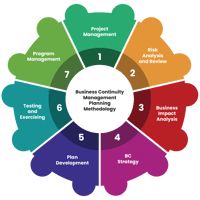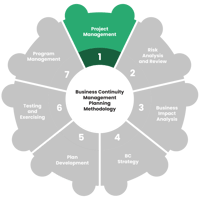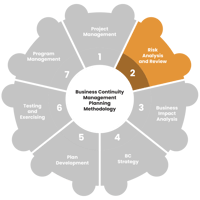eBook 2: Chapter 1
Implementing Business Continuity Management Planning Methodology for the Pavilion KL
Introduction
![[BCM] [GEN] [E2] [C1] Business Continuity Management Planning Methodology](https://blog.bcm-institute.org/hs-fs/hubfs/eBook%20Generic%20Morepost/BCM/BCM%20GEN%20E2/%5BBCM%5D%20%5BGEN%5D%20%5BE2%5D%20%5BC1%5D%20Business%20Continuity%20Management%20Planning%20Methodology.png?width=186&height=186&name=%5BBCM%5D%20%5BGEN%5D%20%5BE2%5D%20%5BC1%5D%20Business%20Continuity%20Management%20Planning%20Methodology.png) Business Continuity Management (BCM) is an essential discipline for organisations aiming to safeguard their operations against disruptions.
Business Continuity Management (BCM) is an essential discipline for organisations aiming to safeguard their operations against disruptions.
For retail environments like Pavilion Kuala Lumpur, the importance of BCM cannot be overstated.
A disruption—whether from natural disasters, technical failures, or supply chain interruptions—can have significant consequences for business operations, customer experience, and brand reputation.
Pavilion Kuala Lumpur, as one of Malaysia’s premier shopping malls, needs a robust BCM framework to ensure that it can continue delivering uninterrupted service, protect its critical functions, and recover swiftly from any disruption.
This chapter explores the Business Continuity Management Planning Methodology used by Pavilion Kuala Lumpur, aligned with ISO 22301, the global standard for BCM.
Implementing Business Continuity Management Planning Methodology
 This chapter outlines Pavilion KL’s BCM Planning Methodology, structured around seven key phases:
This chapter outlines Pavilion KL’s BCM Planning Methodology, structured around seven key phases:
- Project Management (PM)
- Risk Analysis and Review (RAR)
- Business Impact Analysis (BIA)
- Business Continuity Strategy (BCS)
- Plan Development (PD)
- Testing and Exercising (TE)
- Program Management (PgM)
These phases work together to ensure a cohesive approach to resilience, addressing both the strategic and operational aspects necessary to keep Pavilion Kuala Lumpur functioning in the face of unexpected events.
Project Management (PM)
The first phase of the BCM methodology is Project Management (PM).
It lays the foundation for the entire BCM initiative by ensuring the project is correctly scoped, resourced, and governed.
Pavilion KL-specific Requirement
For Pavilion Kuala Lumpur, this phase involves:
- Establishing a Project Steering Committee that includes representatives from key departments such as operations, security, IT, and tenant management.
- Defining objectives and deliverables, including BCM plans, risk assessments, and recovery strategies.
- Securing necessary resources—both human and financial—to support the BCM efforts, including allocating dedicated BCM personnel or external consultants with expertise in retail operations.
- Developing a timeline that aligns with the operational priorities of the mall while ensuring BCM plans are reviewed and updated regularly.
This phase ensures that the BCM project is aligned with the mall’s strategic goals and that all stakeholders are on the same page.
Risk Analysis and Review (RAR)
In this phase, the objective is to identify, assess, and prioritise risks that could potentially disrupt operations at Pavilion Kuala Lumpur.
For the mall, this would involve:
Pavilion KL-specific Requirement
- Conducting a comprehensive risk assessment that includes physical risks (e.g., fire, flooding, power outages), security threats (e.g., terrorism, theft), and operational risks (e.g., supply chain failure, tenant closures).
- Reviewing historical data from past disruptions, both internal and external, to understand the likelihood and impact of potential risks.
- Engaging with stakeholders, —including tenants, local authorities, and insurance providers —togain a holistic view of risks.
- Categorising risks based on their potential to disrupt high-priority operations such as mall operations, security, retail services, and customer support.
This phase enables Pavilion Kuala Lumpur to focus on the most pressing threats, forming the basis for the Business Impact Analysis (BIA) phase.
Business Impact Analysis (BIA)
 The Business Impact Analysis (BIA) phase is critical for identifying the mall’s Critical Business Functions (CBFs) and assessing the potential impact of disruptions to these functions.
The Business Impact Analysis (BIA) phase is critical for identifying the mall’s Critical Business Functions (CBFs) and assessing the potential impact of disruptions to these functions.
For Pavilion Kuala Lumpur, this phase includes:
Pavilion KL-specific Requirement
- Identifying key CBFs, such as mall operations management, tenant and leasing management, customer experience services, and building facilities management.
- Analysing the impact of disruptions on these functions, explicitly focusing on downtime, financial losses, customer dissatisfaction, and damage to brand reputation.
- Setting Recovery Time Objectives (RTOs) and Recovery Point Objectives (RPOs) for each CBF, defining the maximum tolerable downtime for operations and data loss.
- Establishing a Criticality Index, which ranks functions based on their importance to the mall's overall operation.
The BIA enables Pavilion Kuala Lumpur to prioritise recovery efforts and resources in the event of a disruption.
Business Continuity Strategy (BCS)
Based on the insights gathered during the BIA, the next phase is to develop a Business Continuity Strategy (BCS).
This phase outlines the approach that Pavilion Kuala Lumpur will take to ensure the continuity of operations. Key activities include:
Pavilion KL-specific Requirement
- Developing alternative operating strategies for high-priority functions such as retail operations, security, and tenant management. This might include setting up backup power sources, identifying alternative suppliers, or implementing off-site data storage.
- Allocating resources for business continuity, such as dedicated recovery teams, IT infrastructure, and communications tools.
- Coordinating with tenants and external service providers to ensure that they have continuity plans that align with Pavilion Kuala Lumpur’s overall strategy.
The BCS phase ensures that the mall has multiple options for continuity and can maintain critical functions even in the face of disruptions.
Plan Development (PD)
 The Plan Development (PD) phase is where detailed business continuity plans are created for Pavilion Kuala Lumpur.
The Plan Development (PD) phase is where detailed business continuity plans are created for Pavilion Kuala Lumpur.
This includes:
Pavilion KL-specific Requirement
- Developing specific recovery plans for each identified CBF, such as an evacuation plan for the mall, recovery procedures for tenant leasing operations, and emergency response protocols for building systems.
- Documenting clear roles and responsibilities for the BCM team, security, and other critical personnel.
- Creating communication protocols, both for internal stakeholders (e.g., staff, tenants) and external stakeholders (e.g., customers, emergency services), to ensure quick and precise messaging during a crisis.
- Ensuring the integration of plans with broader emergency management and business strategies for better coordination.
This phase is crucial for ensuring Pavilion Kuala Lumpur has well-structured, actionable plans in place when disruptions occur.
Testing and Exercising (TE)
 Once the plans are developed, the next phase is Testing and Exercising (TE). This phase involves simulating real-world scenarios to test the efficacy of the BCM plans.
Once the plans are developed, the next phase is Testing and Exercising (TE). This phase involves simulating real-world scenarios to test the efficacy of the BCM plans.
For Pavilion Kuala Lumpur, the activities include:
Pavilion KL-specific Requirement
- Conducting regular drills (e.g., fire evacuations, power failure simulations) to ensure that staff and tenants are familiar with the procedures and can execute them under pressure.
- Testing recovery strategies, such as switching to backup power systems, activating emergency communications, and recovering IT systems.
- Review and update plans based on test results to address any gaps or deficiencies identified during the exercises.
The testing phase ensures that the BCM plans are practical, effective, and executable in a real disruption.
Program Management (PgM)
 The final phase, Program Management (PgM), involves overseeing and maintaining the BCM program over time. This phase includes:
The final phase, Program Management (PgM), involves overseeing and maintaining the BCM program over time. This phase includes:
Pavilion KL-specific Requirement
- Continuous monitoring of risks, changes in operations, and emerging threats to keep the BCM plans relevant.
- Regular reviews and updates of the BCM program, ensuring that it remains aligned with Pavilion Kuala Lumpur’s evolving business operations and regulatory requirements.
- Ongoing training and awareness programs to ensure that all staff, tenants, and partners are informed about their roles and responsibilities in business continuity.
- Ensuring executive support for the BCM program, including regular briefings to management on the status of BCM initiatives.
Program management ensures the BCM framework is kept dynamic and responsive to the mall’s changing needs.
Implementing a Business Continuity Management Planning Methodology at Pavilion Kuala Lumpur is essential to maintaining resilience in the face of potential disruptions.
By following the seven phases—Project Management, Risk Analysis and Review, Business Impact Analysis, Business Continuity Strategy, Plan Development, Testing and Exercising, and Program Management—the mall can proactively prepare for any crisis, minimise its impact, and recover swiftly.
Pavilion Kuala Lumpur’s commitment to BCM not only protects its own operations but also provides assurance to its tenants, customers, and stakeholders that it is dedicated to maintaining a safe, reliable, and resilient retail environment.
With this structured approach, Pavilion Kuala Lumpur can remain a premier shopping destination for years to come.




![BCM E2 PM [Introduction BCM Planning Methodology] Banner](https://blog.bcm-institute.org/hs-fs/hubfs/BCM%20E2%20Blog%20Banner/BCM%20E2%20PM%20%5BIntroduction%20BCM%20Planning%20Methodology%5D%20Banner.png?width=1920&height=384&name=BCM%20E2%20PM%20%5BIntroduction%20BCM%20Planning%20Methodology%5D%20Banner.png)






![Register [BL-B-3]*](https://no-cache.hubspot.com/cta/default/3893111/ac6cf073-4cdd-4541-91ed-889f731d5076.png)



![FAQ [BL-B-3]](https://no-cache.hubspot.com/cta/default/3893111/b3824ba1-7aa1-4eb6-bef8-94f57121c5ae.png)
![Email to Sales Team [BCM Institute]](https://no-cache.hubspot.com/cta/default/3893111/3c53daeb-2836-4843-b0e0-645baee2ab9e.png)





